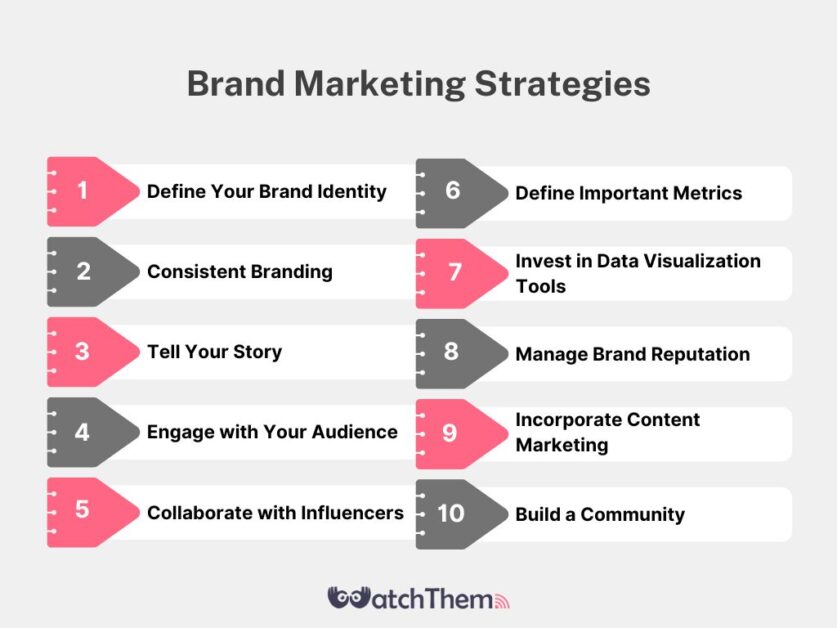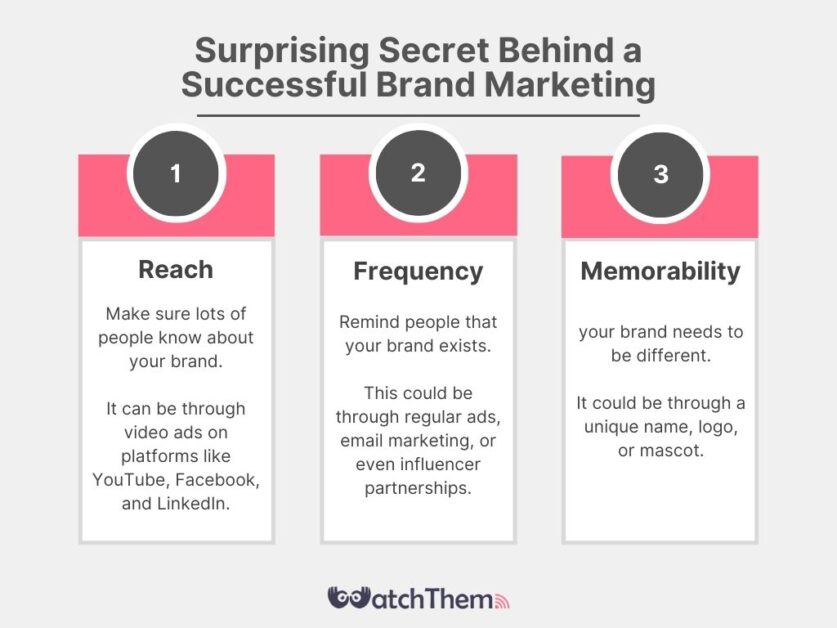Page Contents
In today’s competitive market, brand marketing plays a crucial role in the success of any business. So, whether you’re a small startup or an established company, investing in this type of marketing is an investment worth making.
But what exactly is brand marketing, and why is it so important? Let’s delve into the world of marketing branding and discover how it can augment your business among its competitors.
Brand Marketing Definition
Let’s start by defining brand marketing.
In general, when we talk about brand marketing, we mean creating a unique identity and perception for your business in the minds of consumers. It goes beyond just promoting your products or services; it’s about creating a story, a personality, and a promise that resonates with your target audience.
It’s about creating an emotional connection with your customers and building trust over time. This involves everything from your company’s name and logo to its online presence, customer interactions, and more.
A great way to understand brand marketing is to look at it next to performance marketing. So, let’s compare these two types of marketing to see what are the differences and how they are correlated.
Brand Marketing vs. Performance Marketing
Knowing the differences between brand marketing and performance marketing can help you focus on better goals and follow the correct metrics for each marketing type. Here are how these two concepts are different:
| Brand Marketing | Performance Marketing | |
| Goal | focuses on building brand awareness, reputation, and loyalty over the long term. | is more focused on driving immediate, measurable actions, such as clicks, leads, conversions, and sales. |
| Focus | emphasizes creating a strong brand image, establishing an emotional connection with customers, and shaping perception. | emphasizes direct response and achieving specific, measurable results within a shorter timeframe. |
| Metrics | Success in brand marketing is often measured through metrics like brand awareness, brand recall, brand sentiment, and engagement. | Success in performance marketing is often measured through metrics like click-through rates, conversion rates, return on investment (ROI), and cost per acquisition (CPA). |
| Channels | Common channels for brand marketing include television ads, print ads, sponsorships, events, and social media campaigns. | Channels for performance marketing include search engine marketing (SEM), social media advertising, affiliate marketing, and email marketing. |
| Timeframe | Brand marketing is more about long-term strategies and building a sustainable brand presence in the market. | Performance marketing is more about short-term campaigns geared towards driving immediate results. |
What is the Importance of Brand Marketing?
Now that you know how branding marketing is different from performance marketing, you may wonder why you need to do both of them. You should note that each type of marketing can bring distinctive result for your business.
Let’s check out the benefits of brand marketing to see what it has for you.
One key benefit of effective brand marketing is building brand loyalty. When consumers connect with your brand on a deeper level, they are more likely to remain loyal customers and even become advocates for your brand, spreading positive word-of-mouth.
Moreover, a strong brand can command higher prices and increase customer retention rates. When consumers perceive your brand as valuable and trustworthy, they are willing to pay a premium for your products or services and are more likely to stick with it over the long term.
Brand Marketing Strategies
So, how can you use the power of brand marketing for your business? Here are some simple yet effective strategies to get you started:


1. Define Your Brand Identity
Start by clearly defining what your brand stands for, what sets it apart from the competition, and what values it represents. This will serve as the foundation for all of your brand marketing efforts.
2. Consistent Branding
Ensure consistency across all touchpoints, including your logo, colors, messaging, and tone of voice. Consistent branding helps reinforce your brand identity and makes it easier for consumers to recognize and remember your brand.
3. Tell Your Story
Every brand has a story to tell. Share your brand’s journey, values, and mission with your audience through compelling storytelling. This helps create an emotional connection with consumers and humanizes your brand.
4. Engage with Your Audience
Build meaningful relationships with your audience by engaging with them on social media, responding to their comments and messages, and soliciting their feedback. This shows that you value their input and helps foster trust and loyalty.
5. Collaborate with Influencers
Partner with influencers who align with your brand values and have a strong following in your target market. Influencer marketing can help increase brand awareness and credibility among your target audience.
6. Define Important Metrics
It’s essential to know what you want to get from your brand marketing campaign. Therefore, you need to determine what metrics matter to your brand and track them consistently. Therefore, after selecting your goal, find the metric that you should follow to reach this result.
7. Invest in Data Visualization Tools
Use tools to measure and visualize your brand equity, even if it’s challenging. For example, you can select marketing automation tools to speed up different processes in your campaigns or track what your visitors do on your website with website visitor tracking tools.
8. Manage Brand Reputation
Monitor and manage online reviews, social media mentions, and customer feedback to maintain a positive brand reputation and address any negative sentiment promptly.
9. Incorporate Content Marketing
Develop content that aligns with your brand values and resonates with your target audience. This can include blogs, videos, social media posts, and other forms of content that showcase the personality and values of your brand.
You can use content marketing tools to simplify your content marketing efforts.
10. Build a Community
Create a sense of community around your brand through online and offline engagements, forums, social media groups, and events to strengthen customer relationships and brand loyalty.
The Surprising Secret Behind a Successful Brand Marketing
In the world of business, we often hear about companies spending big bucks on their logos and brand designs. But did you know that the true value of a brand doesn’t solely lie in its fancy logo or sleek design? Surprisingly, it’s something much simpler: reach, frequency, and memorability.
Let’s break it down.


Reach: Getting Your Brand Out There
Reach is all about making sure lots of people know about your brand. Think about it this way: if nobody knows about your brand, nobody will buy from you. So, how do you increase your reach?
One effective method is through video ads on platforms like YouTube, Facebook, and LinkedIn. These platforms reach millions of people every day, and if your ad catches their attention, they might remember your brand.
Frequency: Staying on People’s Minds
Imagine hearing about a brand once and then forgetting about it. That’s not good for business. Frequency is about consistently reminding people that your brand exists. This could be through regular ads, email marketing, or even influencer partnerships.
Memorability: Standing Out from the Crowd
Ever noticed how some brands stick in your mind while others fade into the background? That’s memorability in action. To be memorable, your brand needs to be different. It could be through a unique name, logo, or mascot.
For example, think about the insurance company Lemonade. Their name and pink branding stand out in a sea of bland insurance companies. Research shows that being memorable is crucial for brand success.
Examples of Brand Marketing
It’s time to check out some of the top brands with successful brand marketing strategies.
Patagonia
A prime example of successful brand marketing is Patagonia, an outdoor clothing brand. Patagonia didn’t just sell products; it built a brand image based on quality, transparency, and reliability. By consistently delivering high-quality products and exceptional customer service, Patagonia earned the trust and loyalty of its customers, making them think of the brand first when in need of outdoor gear.


Nike
What do you remember when you hear the name ‘Nike’ or see its simple logo?
Nike is known for its powerful brand marketing campaigns that focus on inspiring athletes and promoting a “just do it” attitude. Their iconic “Dream Crazy” campaign featuring Colin Kaepernick sparked conversations around social issues and received both praise and criticism, ultimately reinforcing Nike’s brand values of empowerment and inclusivity.


Apple
These days, Apple is not known as a fruit anymore! When we hear the name Apple, we directly remember a mobile phone and a bitten Apple logo. That’s how Apple could make a name for its brand and stand out from the crowd.
Apple’s brand marketing is centered around sleek design, innovation, and simplicity. Their “Think Different” campaign celebrated visionary figures like Albert Einstein and Mahatma Gandhi, positioning Apple as a brand for creative and innovative individuals.


FAQs
What Does Brand Marketing Cover?
Brand marketing involves strategic partnerships, community building, content creation, and customer engagement to effectively communicate the brand’s values and differentiate it in the market, ultimately establishing a long-lasting relationship with customers and driving brand success.
How Do You Create a Brand Marketing Strategy?
- Define Your Brand.
- Analyze market trends.
- Develop Your Brand Identity.
- Craft Your Brand Story.
- Identify Brand Channels.
- Create Brand Marketing Tactics.
- Establish key performance indicators (KPIs).
- Stay Consistent.
- Engage with Your Audience.
Bottom Line
Brands aren’t just about pretty logos; they’re valuable assets that create psychological connections with consumers. While products provide tangible benefits, brands create emotional attachments that keep customers coming back for more.
By implementing these strategies and prioritizing brand marketing in your overall marketing strategy, you can establish a strong brand presence, foster customer loyalty, and ultimately drive business growth. Don’t underestimate the power of brand marketing – it could be the key to unlocking the success of your business!

